Biological Markers: Problem-Based Report on a Mixed Medical Case
VerifiedAdded on 2023/04/21
|5
|1196
|318
Report
AI Summary
This problem-based report addresses a medical case involving mixed-up biological samples and conflicting patient data. The report begins by highlighting the importance of accurate medical records in patient management but notes the prevalence of errors. It analyzes a case where a patient presented with symptoms indicative of diabetes and anemia, yet initial blood tests showed normal glucose and hematocrit levels, suggesting a case mix-up. The analysis contrasts the expected blood profiles for diabetic and anemic conditions, emphasizing the importance of further diagnostic tests such as blood glucose tests (fasting and post-meal) and complete blood counts to accurately diagnose the patient's condition. The report concludes by stressing the need for careful data interpretation to differentiate between diabetes, anemia, or a combination of both, and to ensure appropriate patient care. Desklib provides similar reports and solved assignments for students.
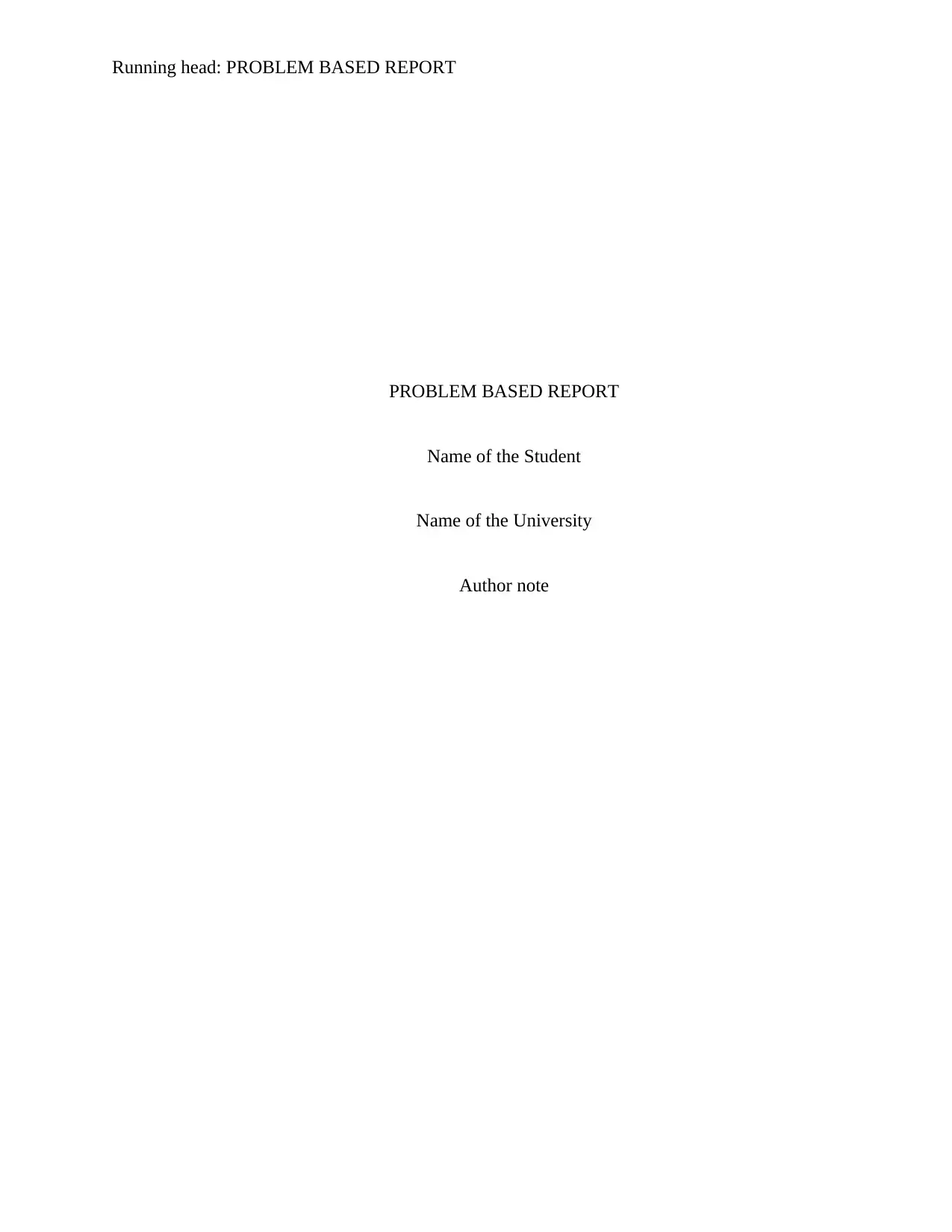
Running head: PROBLEM BASED REPORT
PROBLEM BASED REPORT
Name of the Student
Name of the University
Author note
PROBLEM BASED REPORT
Name of the Student
Name of the University
Author note
Paraphrase This Document
Need a fresh take? Get an instant paraphrase of this document with our AI Paraphraser
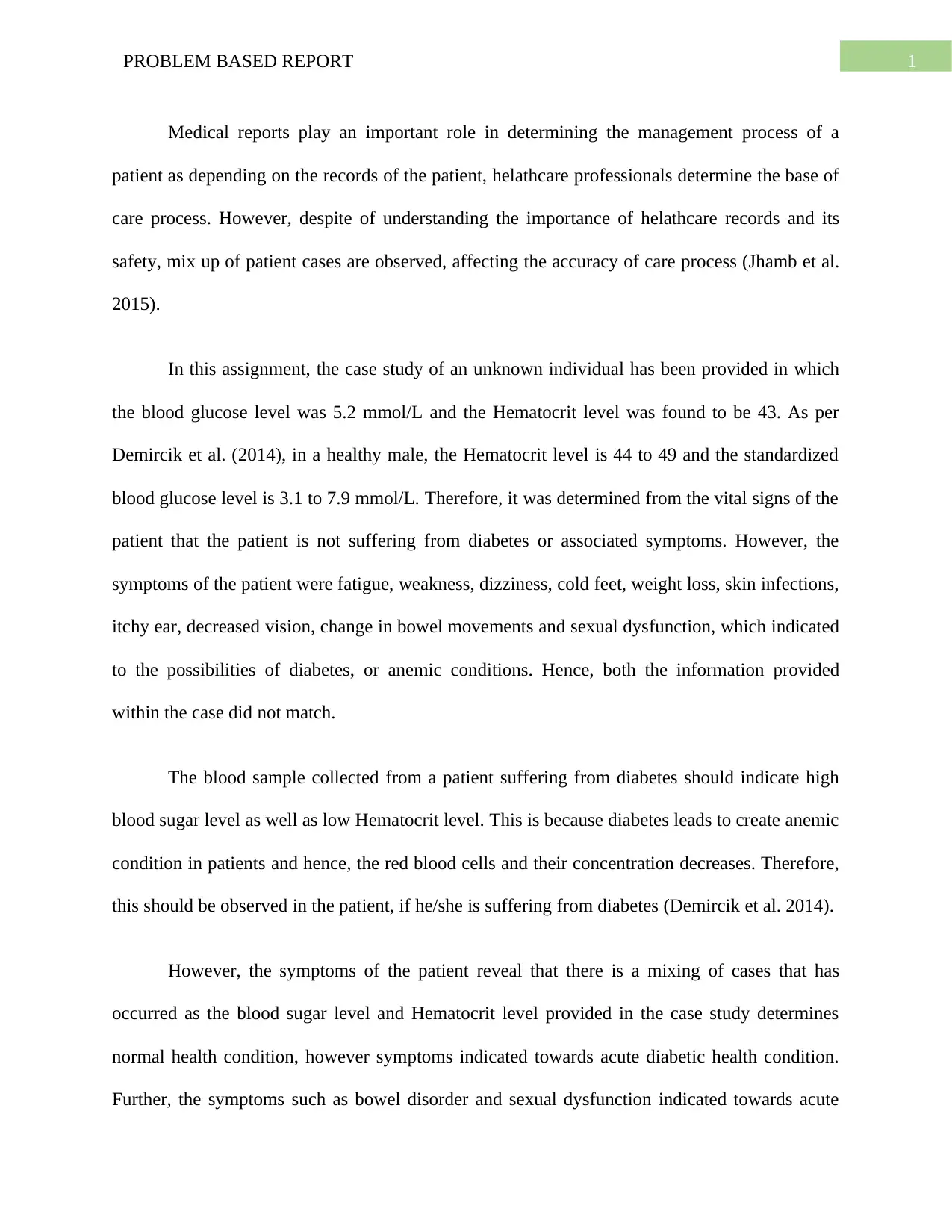
1PROBLEM BASED REPORT
Medical reports play an important role in determining the management process of a
patient as depending on the records of the patient, helathcare professionals determine the base of
care process. However, despite of understanding the importance of helathcare records and its
safety, mix up of patient cases are observed, affecting the accuracy of care process (Jhamb et al.
2015).
In this assignment, the case study of an unknown individual has been provided in which
the blood glucose level was 5.2 mmol/L and the Hematocrit level was found to be 43. As per
Demircik et al. (2014), in a healthy male, the Hematocrit level is 44 to 49 and the standardized
blood glucose level is 3.1 to 7.9 mmol/L. Therefore, it was determined from the vital signs of the
patient that the patient is not suffering from diabetes or associated symptoms. However, the
symptoms of the patient were fatigue, weakness, dizziness, cold feet, weight loss, skin infections,
itchy ear, decreased vision, change in bowel movements and sexual dysfunction, which indicated
to the possibilities of diabetes, or anemic conditions. Hence, both the information provided
within the case did not match.
The blood sample collected from a patient suffering from diabetes should indicate high
blood sugar level as well as low Hematocrit level. This is because diabetes leads to create anemic
condition in patients and hence, the red blood cells and their concentration decreases. Therefore,
this should be observed in the patient, if he/she is suffering from diabetes (Demircik et al. 2014).
However, the symptoms of the patient reveal that there is a mixing of cases that has
occurred as the blood sugar level and Hematocrit level provided in the case study determines
normal health condition, however symptoms indicated towards acute diabetic health condition.
Further, the symptoms such as bowel disorder and sexual dysfunction indicated towards acute
Medical reports play an important role in determining the management process of a
patient as depending on the records of the patient, helathcare professionals determine the base of
care process. However, despite of understanding the importance of helathcare records and its
safety, mix up of patient cases are observed, affecting the accuracy of care process (Jhamb et al.
2015).
In this assignment, the case study of an unknown individual has been provided in which
the blood glucose level was 5.2 mmol/L and the Hematocrit level was found to be 43. As per
Demircik et al. (2014), in a healthy male, the Hematocrit level is 44 to 49 and the standardized
blood glucose level is 3.1 to 7.9 mmol/L. Therefore, it was determined from the vital signs of the
patient that the patient is not suffering from diabetes or associated symptoms. However, the
symptoms of the patient were fatigue, weakness, dizziness, cold feet, weight loss, skin infections,
itchy ear, decreased vision, change in bowel movements and sexual dysfunction, which indicated
to the possibilities of diabetes, or anemic conditions. Hence, both the information provided
within the case did not match.
The blood sample collected from a patient suffering from diabetes should indicate high
blood sugar level as well as low Hematocrit level. This is because diabetes leads to create anemic
condition in patients and hence, the red blood cells and their concentration decreases. Therefore,
this should be observed in the patient, if he/she is suffering from diabetes (Demircik et al. 2014).
However, the symptoms of the patient reveal that there is a mixing of cases that has
occurred as the blood sugar level and Hematocrit level provided in the case study determines
normal health condition, however symptoms indicated towards acute diabetic health condition.
Further, the symptoms such as bowel disorder and sexual dysfunction indicated towards acute
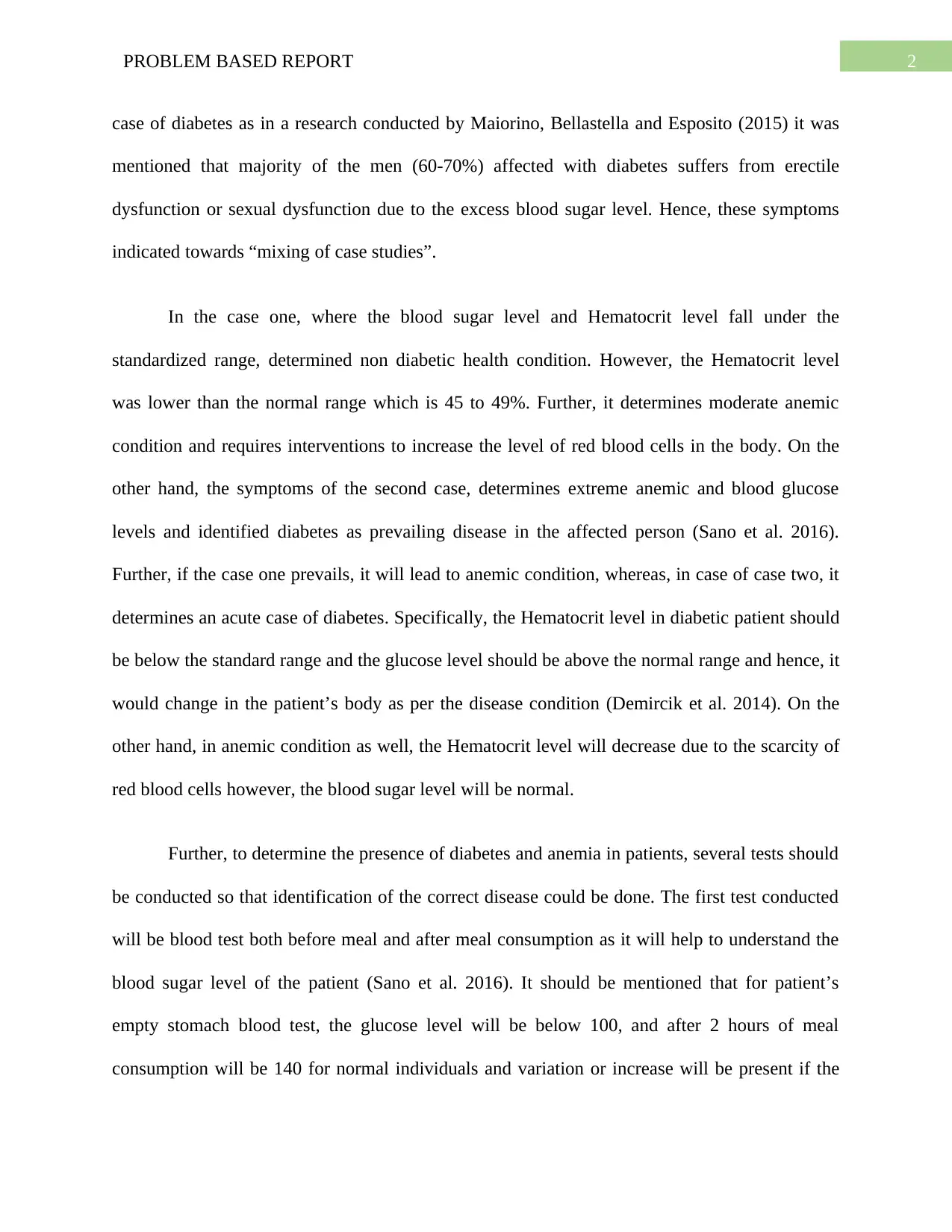
2PROBLEM BASED REPORT
case of diabetes as in a research conducted by Maiorino, Bellastella and Esposito (2015) it was
mentioned that majority of the men (60-70%) affected with diabetes suffers from erectile
dysfunction or sexual dysfunction due to the excess blood sugar level. Hence, these symptoms
indicated towards “mixing of case studies”.
In the case one, where the blood sugar level and Hematocrit level fall under the
standardized range, determined non diabetic health condition. However, the Hematocrit level
was lower than the normal range which is 45 to 49%. Further, it determines moderate anemic
condition and requires interventions to increase the level of red blood cells in the body. On the
other hand, the symptoms of the second case, determines extreme anemic and blood glucose
levels and identified diabetes as prevailing disease in the affected person (Sano et al. 2016).
Further, if the case one prevails, it will lead to anemic condition, whereas, in case of case two, it
determines an acute case of diabetes. Specifically, the Hematocrit level in diabetic patient should
be below the standard range and the glucose level should be above the normal range and hence, it
would change in the patient’s body as per the disease condition (Demircik et al. 2014). On the
other hand, in anemic condition as well, the Hematocrit level will decrease due to the scarcity of
red blood cells however, the blood sugar level will be normal.
Further, to determine the presence of diabetes and anemia in patients, several tests should
be conducted so that identification of the correct disease could be done. The first test conducted
will be blood test both before meal and after meal consumption as it will help to understand the
blood sugar level of the patient (Sano et al. 2016). It should be mentioned that for patient’s
empty stomach blood test, the glucose level will be below 100, and after 2 hours of meal
consumption will be 140 for normal individuals and variation or increase will be present if the
case of diabetes as in a research conducted by Maiorino, Bellastella and Esposito (2015) it was
mentioned that majority of the men (60-70%) affected with diabetes suffers from erectile
dysfunction or sexual dysfunction due to the excess blood sugar level. Hence, these symptoms
indicated towards “mixing of case studies”.
In the case one, where the blood sugar level and Hematocrit level fall under the
standardized range, determined non diabetic health condition. However, the Hematocrit level
was lower than the normal range which is 45 to 49%. Further, it determines moderate anemic
condition and requires interventions to increase the level of red blood cells in the body. On the
other hand, the symptoms of the second case, determines extreme anemic and blood glucose
levels and identified diabetes as prevailing disease in the affected person (Sano et al. 2016).
Further, if the case one prevails, it will lead to anemic condition, whereas, in case of case two, it
determines an acute case of diabetes. Specifically, the Hematocrit level in diabetic patient should
be below the standard range and the glucose level should be above the normal range and hence, it
would change in the patient’s body as per the disease condition (Demircik et al. 2014). On the
other hand, in anemic condition as well, the Hematocrit level will decrease due to the scarcity of
red blood cells however, the blood sugar level will be normal.
Further, to determine the presence of diabetes and anemia in patients, several tests should
be conducted so that identification of the correct disease could be done. The first test conducted
will be blood test both before meal and after meal consumption as it will help to understand the
blood sugar level of the patient (Sano et al. 2016). It should be mentioned that for patient’s
empty stomach blood test, the glucose level will be below 100, and after 2 hours of meal
consumption will be 140 for normal individuals and variation or increase will be present if the
⊘ This is a preview!⊘
Do you want full access?
Subscribe today to unlock all pages.

Trusted by 1+ million students worldwide
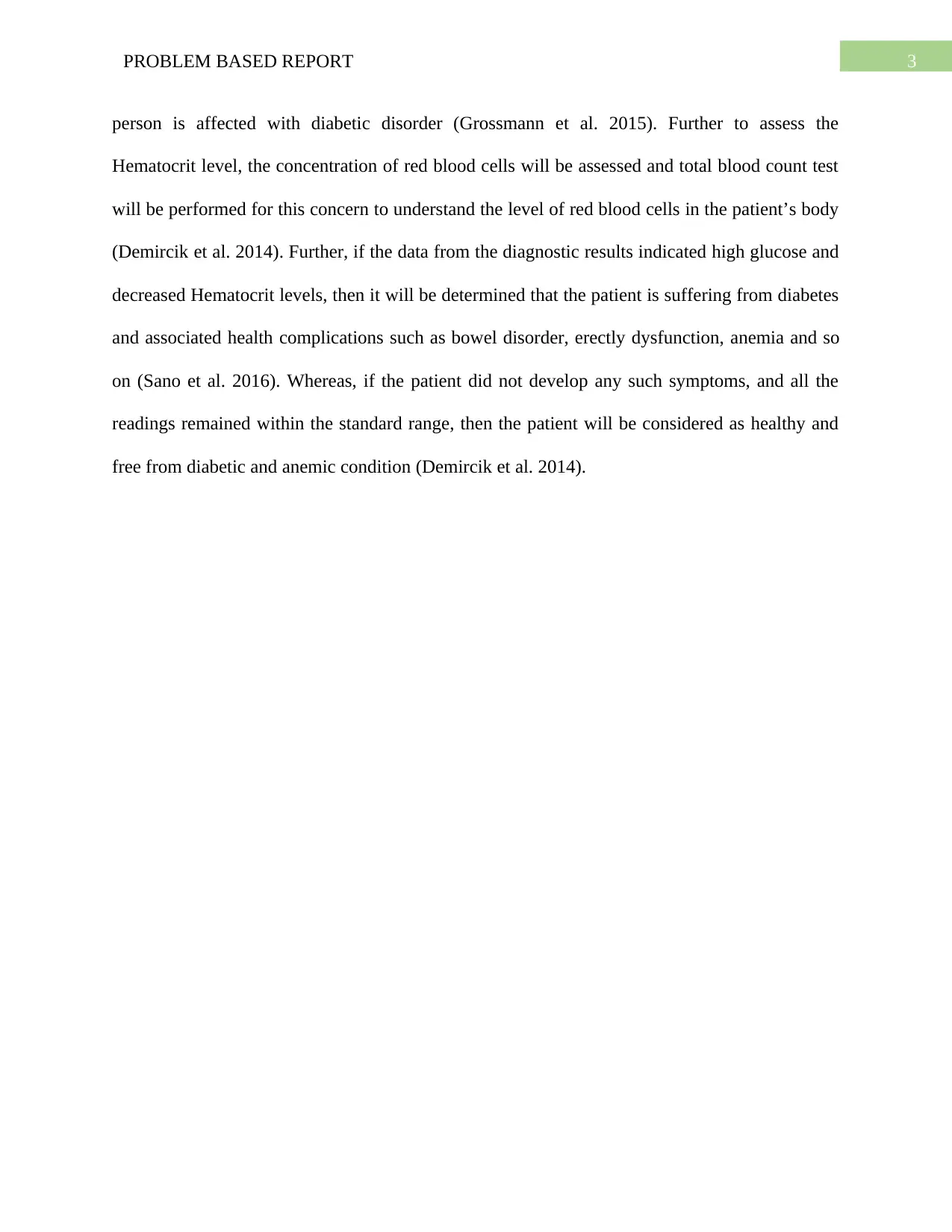
3PROBLEM BASED REPORT
person is affected with diabetic disorder (Grossmann et al. 2015). Further to assess the
Hematocrit level, the concentration of red blood cells will be assessed and total blood count test
will be performed for this concern to understand the level of red blood cells in the patient’s body
(Demircik et al. 2014). Further, if the data from the diagnostic results indicated high glucose and
decreased Hematocrit levels, then it will be determined that the patient is suffering from diabetes
and associated health complications such as bowel disorder, erectly dysfunction, anemia and so
on (Sano et al. 2016). Whereas, if the patient did not develop any such symptoms, and all the
readings remained within the standard range, then the patient will be considered as healthy and
free from diabetic and anemic condition (Demircik et al. 2014).
person is affected with diabetic disorder (Grossmann et al. 2015). Further to assess the
Hematocrit level, the concentration of red blood cells will be assessed and total blood count test
will be performed for this concern to understand the level of red blood cells in the patient’s body
(Demircik et al. 2014). Further, if the data from the diagnostic results indicated high glucose and
decreased Hematocrit levels, then it will be determined that the patient is suffering from diabetes
and associated health complications such as bowel disorder, erectly dysfunction, anemia and so
on (Sano et al. 2016). Whereas, if the patient did not develop any such symptoms, and all the
readings remained within the standard range, then the patient will be considered as healthy and
free from diabetic and anemic condition (Demircik et al. 2014).
Paraphrase This Document
Need a fresh take? Get an instant paraphrase of this document with our AI Paraphraser
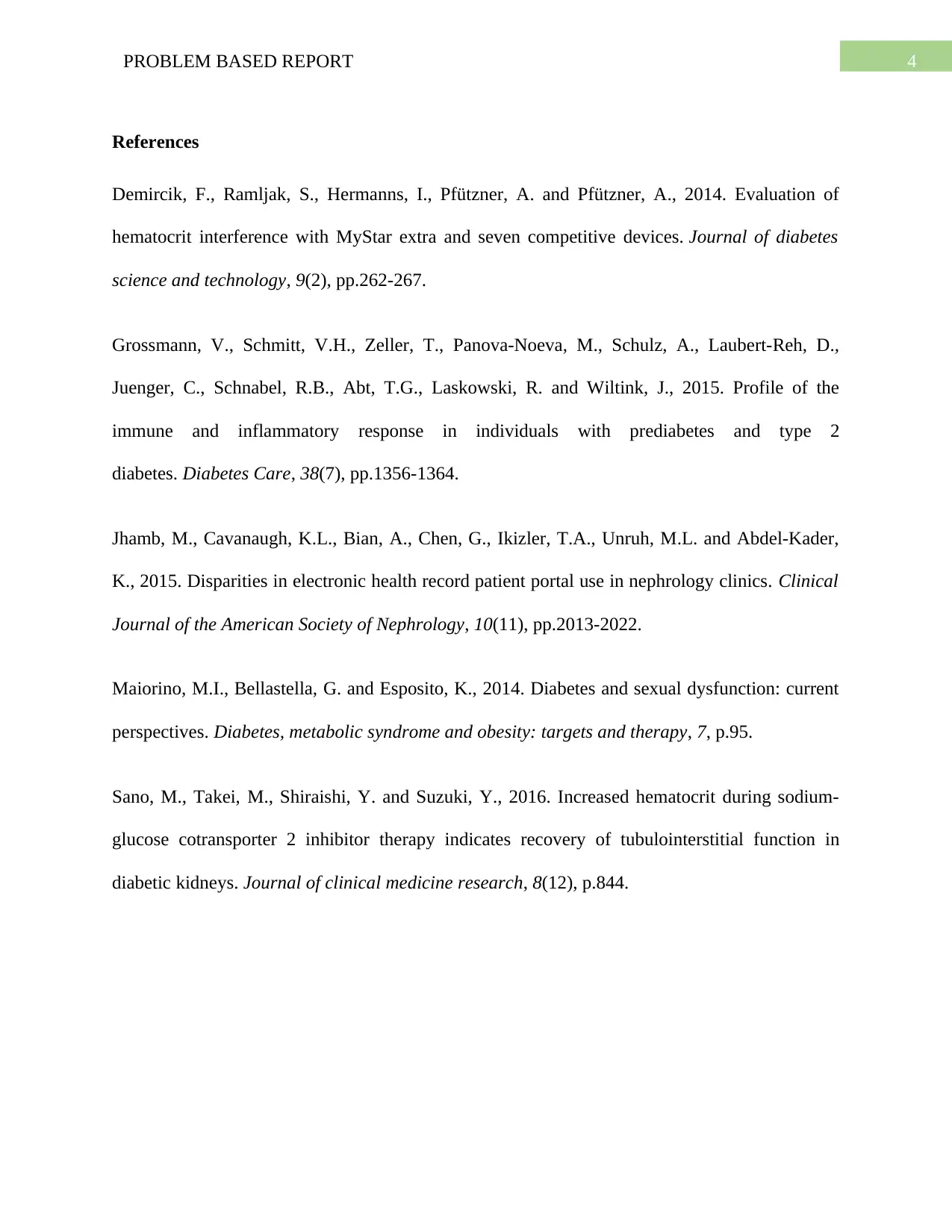
4PROBLEM BASED REPORT
References
Demircik, F., Ramljak, S., Hermanns, I., Pfützner, A. and Pfützner, A., 2014. Evaluation of
hematocrit interference with MyStar extra and seven competitive devices. Journal of diabetes
science and technology, 9(2), pp.262-267.
Grossmann, V., Schmitt, V.H., Zeller, T., Panova-Noeva, M., Schulz, A., Laubert-Reh, D.,
Juenger, C., Schnabel, R.B., Abt, T.G., Laskowski, R. and Wiltink, J., 2015. Profile of the
immune and inflammatory response in individuals with prediabetes and type 2
diabetes. Diabetes Care, 38(7), pp.1356-1364.
Jhamb, M., Cavanaugh, K.L., Bian, A., Chen, G., Ikizler, T.A., Unruh, M.L. and Abdel-Kader,
K., 2015. Disparities in electronic health record patient portal use in nephrology clinics. Clinical
Journal of the American Society of Nephrology, 10(11), pp.2013-2022.
Maiorino, M.I., Bellastella, G. and Esposito, K., 2014. Diabetes and sexual dysfunction: current
perspectives. Diabetes, metabolic syndrome and obesity: targets and therapy, 7, p.95.
Sano, M., Takei, M., Shiraishi, Y. and Suzuki, Y., 2016. Increased hematocrit during sodium-
glucose cotransporter 2 inhibitor therapy indicates recovery of tubulointerstitial function in
diabetic kidneys. Journal of clinical medicine research, 8(12), p.844.
References
Demircik, F., Ramljak, S., Hermanns, I., Pfützner, A. and Pfützner, A., 2014. Evaluation of
hematocrit interference with MyStar extra and seven competitive devices. Journal of diabetes
science and technology, 9(2), pp.262-267.
Grossmann, V., Schmitt, V.H., Zeller, T., Panova-Noeva, M., Schulz, A., Laubert-Reh, D.,
Juenger, C., Schnabel, R.B., Abt, T.G., Laskowski, R. and Wiltink, J., 2015. Profile of the
immune and inflammatory response in individuals with prediabetes and type 2
diabetes. Diabetes Care, 38(7), pp.1356-1364.
Jhamb, M., Cavanaugh, K.L., Bian, A., Chen, G., Ikizler, T.A., Unruh, M.L. and Abdel-Kader,
K., 2015. Disparities in electronic health record patient portal use in nephrology clinics. Clinical
Journal of the American Society of Nephrology, 10(11), pp.2013-2022.
Maiorino, M.I., Bellastella, G. and Esposito, K., 2014. Diabetes and sexual dysfunction: current
perspectives. Diabetes, metabolic syndrome and obesity: targets and therapy, 7, p.95.
Sano, M., Takei, M., Shiraishi, Y. and Suzuki, Y., 2016. Increased hematocrit during sodium-
glucose cotransporter 2 inhibitor therapy indicates recovery of tubulointerstitial function in
diabetic kidneys. Journal of clinical medicine research, 8(12), p.844.
1 out of 5
Related Documents
Your All-in-One AI-Powered Toolkit for Academic Success.
+13062052269
info@desklib.com
Available 24*7 on WhatsApp / Email
![[object Object]](/_next/static/media/star-bottom.7253800d.svg)
Unlock your academic potential
Copyright © 2020–2025 A2Z Services. All Rights Reserved. Developed and managed by ZUCOL.





